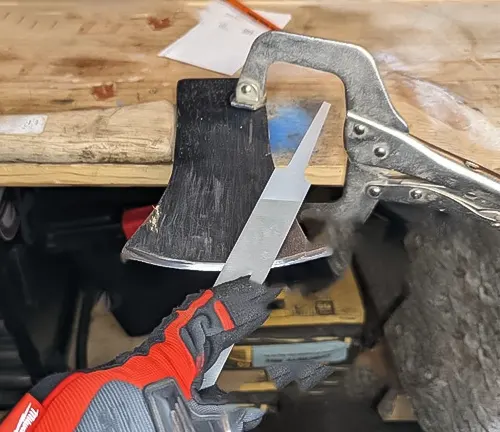If you’re a serious lumberjack or outdoor enthusiast, you know the importance of having your axe in top condition. A dull blade can make even the simplest task a hassle, while a sharp one will glide effortlessly through whatever you need it to cut. That’s why investing in an axe sharpening tool is essential for anyone who uses an axe on a regular basis.
In this article, we’ll discuss everything you need to know about axe sharpening tools, including how to choose the right one for your needs, how to use it properly, and how to maintain your blades over time.
Choosing the Right Axe Sharpening Tool
There are several different types of axe sharpening tools available on the market, each with its own unique features and benefits. Here are some of the most common options:
1. Whetstones – Whetstones are one of the oldest and most traditional methods of sharpening axes. They come in various grits and sizes, allowing you to choose the perfect stone for your specific needs. While they require a bit of practice to master, once you get the hang of using a whetstone, it can produce razor-sharp edges on your blades.
2. File – A file is another classic method of sharpening axes. It’s easy to use and produces consistent results every time. However, it’s not as versatile as other types of sharpeners, since it can only be used on flat surfaces.
3. Electric Grinders – Electric grinders are quick and convenient, making them a popular choice among professionals. They’re also great for restoring severely damaged blades. However, they can be expensive and difficult to use if you’re not familiar with them.
4. Honing Rods – Honing rods are similar to whetstones but are typically smaller and more portable. They’re great for touch-ups on the go, but may not produce as sharp of an edge as other methods.
Ultimately, the type of axe sharpening tool you choose will depend on your personal preferences and needs. If you’re new to sharpening axes, it’s a good idea to start with a whetstone or file until you get the hang of it.
Using Your Axe Sharpening Tool
Once you’ve chosen your axe sharpening tool, it’s time to learn how to use it properly. Here are some tips to keep in mind:
1. Secure the Blade – Before sharpening your axe, make sure it’s securely fastened to a solid surface. This will prevent it from moving around while you work, which can be dangerous.
2. Choose the Right Angle – The angle at which you sharpen your blade will depend on the type of axe you have. Generally, a 20-25 degree angle is recommended for most axes.
3. Start with Coarse Grit – If using a whetstone or honing rod, start with a coarse grit and work your way up to finer grits. This will help remove any nicks or chips in the blade before refining its edge.
4. Use Light Pressure – When sharpening your blade, use light pressure and let the tool do the work. Applying too much pressure can damage the blade or create an uneven edge.
5. Test Your Work – Once you’ve finished sharpening your blade, test it by cutting through a piece of wood or paper. If it cuts cleanly and effortlessly, your job is done!
Maintaining Your Blades Over Time
Keeping your blades sharp isn’t a one-time task; it requires regular maintenance over time. Here are some tips to help you maintain your axe blades:
1. Clean Your Blades After Use – Always clean your blades after each use to prevent rust and corrosion from building up.
2. Store Your Axe Properly – Store your axe in a dry place, away from moisture and humidity. This will help prevent rust and ensure it’s ready to use when you need it.
3. Sharpen Your Blades Regularly – Even if you don’t use your axe often, it’s a good idea to sharpen the blade at least once or twice a year to keep it in top condition.
4. Use a Honing Rod for Touch-Ups – If you notice your blade starting to dull, use a honing rod for quick touch-ups instead of waiting until it’s completely dull.
Conclusion
Investing in an axe sharpening tool is essential for anyone who uses an axe on a regular basis. With the right tool and proper technique, you can keep your blades razor sharp and ready for action whenever you need them. Remember to choose the right type of tool for your needs, use it properly, and maintain your blades over time for optimal results.
References:
https://en.wikipedia.org/wiki/Axe
https://www.outdoorlife.com/story/gear/the-axe-sharpening-guide/
https://www.popularmechanics.com/home/tools/how-to/g1726/how-to-sharpen-an-axe/
https://www.husqvarna.com/us/forest/axes/how-to-sharpen-an-axe/




